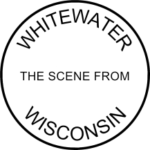 This is the tenth post in a series considering related local topics of cultures & communications within the city.
This is the tenth post in a series considering related local topics of cultures & communications within the city.
Worried over a large-scale party in 2016, Whitewater’s local government set about looking for a plan for 2017. College-aged adults are a plurality of the city’s population; they are a majority of the city’s adult population. Solutions included drafting a mailer (an early version of which I have embedded below), directing possible attendees to a website exhorting them to celebrate responsibility, and hoping for rain to dampen outdoor activities.
(It’s also worth noting that the city recently began using a new drug detection dog, whom officials believe will “just light-up a room,” and with whom residents are “sure to fall in love.” One wishes police K9 Ruso the best, but neither his animal magnetism nor his detection abilities would be of much use during a major celebration, or for many of the unfortunate crimes that otherwise beset small-town Whitewater.)
One can say with confidence that neither mailers, nor dogs, nor municipal websites, nor raindances, nor ice cream socials with elderly residents, nor pictures with smiling children, nor public relations managers are a substitute for the daily trust that comes from genuine community enforcement, with positive relationships with all members of the community. Arms length is no substitute, and belies the value of six, or twenty-six, or sixty-six – however many – proudly-cited years of tenure.
There are few more powerful indictments than decades wasted.
Previously: Parts 1 (introductory assumptions), 2 (population), 3 (oasis), 4 (demographics), 5 (working age), 6 (divided), 7 (how it was supposed to be), 8 (nearby), and 9 (small-town harvards).
Updated: Sunday, 6.18: Part 11.
